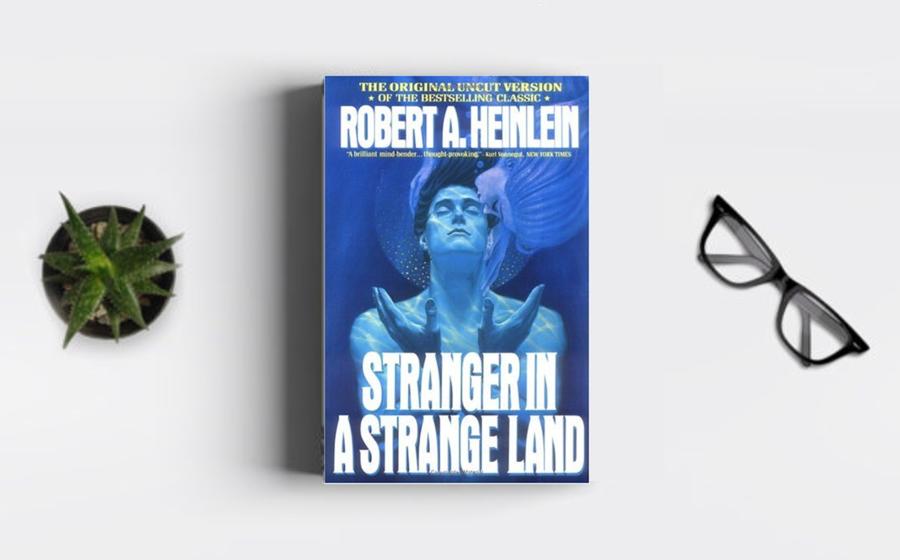Robert A. Heinlein's "Stranger in a Strange Land"
stands as an iconic work that transcends the genre's
conventions, inviting readers on a transformative
journey into the heart of human nature, societal norms,
and the quest for meaning. As we delve into the pages of
this groundbreaking novel, it becomes evident that
"Stranger in a Strange Land" is not merely a tale of an
extraterrestrial visitor; it is a profound exploration
of humanity's potential for growth, understanding, and
the boundaries that define our existence. This literary
classic rightfully claims its place among the top books
of all time, offering readers a thought-provoking
narrative that challenges preconceptions and provokes
existential contemplation.
The heart of "Stranger
in a Strange Land" lies in the arrival of Valentine
Michael Smith, a human raised by Martians on the Red
Planet. This extraterrestrial visitor becomes a thematic
focal point, a narrative device that propels the novel
into a realm of cultural clashes, existential inquiry,
and the exploration of human potential. In the tradition
of literary encounters with the unknown, Smith's arrival
becomes a catalyst for societal reflection, challenging
the status quo and prompting readers to question the
fundamental aspects of human nature.
Heinlein
masterfully crafts a Martian odyssey that resonates with
the literary tradition of exploring cultural clashes and
the transformative impact of the unknown. The novel's
narrative unfolds as Smith, now on Earth, navigates the
intricacies of human society, prompting readers to
reflect on the complexities of human relationships,
societal norms, and the potential for growth beyond
ingrained conventions.
Heinlein introduces the
concept of "grokking," a Martian term that encompasses a
deep, intuitive understanding. The narrative unfolds as
Smith becomes a cultural icon, challenging societal
norms and introducing the idea of free love. In the
tradition of literary societal critiques, the novel
becomes a thematic tapestry that explores the
consequences of rigid social structures and the
potential for individual liberation.
Jubal
Harshaw, a lawyer and mentor to Smith, becomes a
literary guide through this societal critique. Harshaw's
character serves as a vehicle for Heinlein to explore
human relationships, freedom of expression, and the
clash between established norms and the pursuit of
personal enlightenment. The novel transforms into a
sociopolitical exploration that resonates with the
literary tradition of questioning authority and
challenging societal conventions.
Heinlein
introduces the Church of All Worlds, a fictional
religious movement that emerges around the teachings of
Valentine Michael Smith. This narrative element adds
layers of complexity to the novel, as it explores the
intersection of spirituality, organized religion, and
the search for transcendent meaning. In the tradition of
literary examinations of religious themes, "Stranger in
a Strange Land" becomes a thematic undercurrent that
prompts readers to consider the role of spirituality in
shaping human values and the potential for spiritual
evolution.
The religious undertones in the novel
resonate with the literary tradition of exploring
existential questions and the human quest for purpose
and connection. Heinlein's insights add depth to the
text, transforming the narrative into a work where
spiritual exploration becomes a central theme. Readers
are encouraged to contemplate the nature of belief
systems, the role of spirituality in personal growth,
and the potential for transformative experiences that
transcend conventional religious structures.
The
character arc of Valentine Michael Smith represents a
narrative exploration of human potential and the quest
for self-discovery. As Smith adapts to Earth and
interacts with various individuals, his transformation
becomes a thematic tapestry that weaves through the
novel. In the tradition of literary character
development, Smith's journey becomes a narrative device
that invites readers to reflect on the possibilities of
personal growth, the impact of cultural influences, and
the complexities of identity.
The Water Brothers,
a group formed by Smith's followers, further emphasizes
the novel's exploration of human potential. This group
engages in communal living and strives to embody the
ideals of the Martian way of life. Heinlein's narrative
adds layers of meaning, transforming "Stranger in a
Strange Land" into a work that challenges readers to
consider the potential for positive societal change
through shared values, empathy, and the pursuit of a
more harmonious existence.
Heinlein's bold
exploration of free love and alternative lifestyles
reflects the societal shifts of the 1960s, making
"Stranger in a Strange Land" a cultural touchstone that
resonates beyond its pages. The novel's impact on the
sexual revolution and countercultural movements
highlights its enduring relevance and its place within
the broader cultural conversation.
The novel's
cultural impact aligns with the literary tradition of
works that influence societal attitudes and contribute
to conversations about human relationships, freedom, and
self-expression. Heinlein's bold approach to exploring
these themes transforms "Stranger in a Strange Land"
into a work that not only reflects its contemporary
cultural context but continues to prompt discussions
about societal norms and the pursuit of individual and
collective liberation.
"Stranger in a Strange Land," it becomes evident that Robert A. Heinlein's masterpiece is more than a speculative narrative; it is a human odyssey that harmonizes the concepts of Martian arrival, societal critique, religious undertones, human potential, and cultural impact. In the tradition of literary works that transcend genre boundaries.






